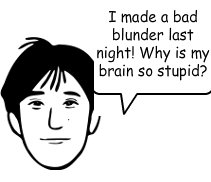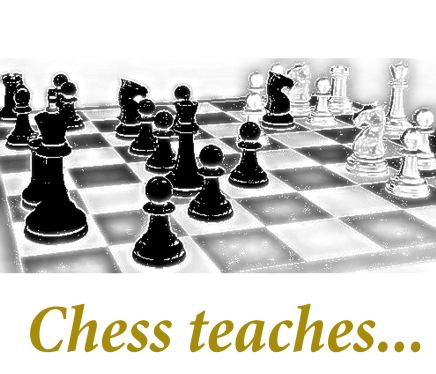I explain various chess strategies and chess ideas to enable you to find the right moves in difficult chess positions that can occur in your chess games. There are countless little chess motifs and it makes sense to study them.
“When you absolutely don’t know what to do anymore, it is time to panic.”
John van der Wiel, Chess Grandmaster
All chess lessons are strictly orientated on reality. Various elements of chess are introduced that occur in real chess games.
Chess Strategy develops a “Winning Plan” that you should have when you play chess. If you don’t have a plan, you will just aimlessly move your pieces around without a purpose or goal. This will lead to the loss of the game on a higher level of play. The plan has to be adjusted move after move. It does change in the course of the game.
A plan is always long-term and depends on the chess position and has to be adjusted from time to time. To create a plan you must look at every single pawn and every single piece. You should analyze the position first before you make a plan.
That means you do not force your will upon your position and make a plan that suits you but not the position. You have to submit your will to the requirements of the position. When your chess position tells you to attack on the kingside, then you don’t attack on the queenside, just because you like to. Always “ask” your position what you should do. And concentration is needed, of course.

UNIQUE Chess Teaching Videos by GRANDMASTER Smirnov!
There are static and dynamic elements in a chess position.
The Static Elements in Chess
The static elements (ex: doubled pawns) stay the way they are and usually cannot be changed. For example you might not be able to dissolve your damaged or weak pawn structure (static).
Dynamic Elements
Dynamic positional elements can be changed and do change in the course of the game.(bishop pair, flexible pawn formation) For example the pawn structure gets blocked and the knights increase in strength. Or the position opens up and the bishops become stronger than the knights.
A good chess player sees those things on the subconscious level. He always knows if he is running behind in material. That means for example, if he is a pawn or a piece up or down. He adjusts his play to this situation accordingly.
Dynamic elements are:
- Strategic threats
- Security of kings
- Control of diagonals and rows
- Pawn structure: isolated pawns, doubled pawns, backward pawns
- Weak squares
- Harmonious piece coordination
You analyze those elements and then you evaluate your position. After that you make a new plan or adjust your old plan.
Get ORIGINAL Chess T-Shirts here!
Get some good chess books.
Study the following Chess Strategies
Central Pawn Strategy
How deals Black with the following white Center Pawn Majority occurring frequently? When you click on the link above, a java chess applet will be loaded – so please be patient!
Mobility of Chess Pieces
The Mobility of Chess Pieces can change during the course of the game. Sometimes it is possible to capitalize on zero mobility of a piece and win it. This happens when a chess piece has no room to move at all when attacked and can be captured afterwards.
Endgame Guidelines
Please read the following guidelines for chess endgames.
Kings and Pawns
Some more endgame training for you.
Kings and Pawn-Structures
In pawn endgames it is sometimes important to devaluate your opponent’s pawn structure or organize a breakthrough with your pawns.
Chess Reality
In practical play it is hard to apply chess principles. The following games should give you some chess reality.
Middlegame Decisions – Chess Studies
In Middlegames it is sometimes hard to find the right plan.
The Minority Attack
The Minority Attack is a basic concept that you should know.
Center Pawn Exchange
Understand this concept about exchanging center pawns.
Ideas in the Veresov Attack
Study this opening setup leading right into the middlegame.
Fix It!
Often you can block a weak pawn structure and attack it afterwards.
It takes time to learn and be able to apply good chess strategies. Chess consists of many useful little strategic ideas. Memorize those ideas to use them in your chess games.
The E-Pawn Advance
Push the E-Pawn! Cramped chess opening setup leads to bad chess position.
The E-Pawn Advance – Throw Sand into the Setup
The Opponent has violated chess principles and gets punished. E-Pawn Push disturbs piece coordination severely.
Bishop Pair
The Bishop Pair and the E-Pawn Advance. Keep your Bishop Pair when the position tends to open up in the near future. Two bishops are working very well together in open positions. You don’t see it, but you feel it!
The Plan in Chess
It is important and vital in chess to formulate a plan of action. You can’t just move your pieces here and there without a plan as you will destroy the coordination of your pieces and ruin the whole setup.
To find a plan you have to ask the right questions. First you have to count your pieces and pawns to see if you are up or down in material. A chess player always knows if he is up or down in material during the game.
Then you have to figure out on which part of the board you have the best chances to succeed and if an inbalance exists.
Look for weak pawns and for weak structures and understand in which direction your pieces should evolve. You might even sacrifice a pawn to execute your plan.
Kasparov versus Deep Blue – Second Match Games
Deep Blue was a big computer developed by IBM. Kasparov was invited to play against this monster. Replay games from the match – Kasparov versus Deep Blue 1997
Isolated Pawn – Chess Game
How to handle the Isolated Pawn?
Strategies of Chess – The Imbalance in a Chess Game
Chess Games tend to become imbalanced over time. Use the Imbalance to your Advantage
Winning Chess Moves – Chess Game
Winning Chess Moves – running behind in Piece Development
Best Chess Books

Get Chess T-Shirts in my Shop…
Compare Chess Piece Potential
Chess Moves – Use your Intuition
Chess Pattern
Recognize Chess Patterns and memorize them for later use! I wish I would have a photographic memory.
Define Targets – Chess Strategy
Choose a target. The following page is a bit rough, I know. But I have to wake you up somehow. LOL
Pawn Majority – Chess Analysis
Use Pawns the right way.
To memorize chess ideas makes sense, as you will be able to apply them in your real games over and over again.
First of all when you want to make a certain move, try to look for arguments why your move is bad. The difference in thinking between a beginner and a master is that beginners try to find reasons, why a specific move they want to make is good, whereas masters try to find reasons why the intended move is bad and they look for ways how the opponent could possibly refute the move.
Think more about the moves and plans of your opponent and less about yourself, falsify your hypothesis then your game will improve in the long run. Change the way you think.
What opening should I play?
Boy, you do ask questions! Just kidding!
What is an Attacking Mark?
In many games you find attacking marks to focus your attack on. Most importantly become aware that they exist.
First get to know some Opening Traps in Chess. These traps are not so easy to understand right away. Some variations go over a long distance before you realize the trap.
What to do with the Isolani?
Often you get or can create an isolani for the opponent. If your opponent has one, then block it, then attack it from all sides and go into the endgame, if you can. The Isolani becomes weaker so more pieces are exchanged and leave the board. In the end you attack the isolani with your king and win this pawn because it is weak.
How to think in Chess?
Chess thinking requires a lot of discipline. To think the right way is vital to avoid blunders and stops your mind to overlook good moves from your opponent.
The power level of each piece changes during the game and depends on the position of the piece. If the position of the piece is bad, then the power level is low. It is possible that a knight has a higher power level than a rook, when it is placed strongly in the center or near the opponents king. Everything is relative.
Lack of Coordination – Chess Piece Moves
Disturb the coordination of your opponents pieces if you can!
Deep Thoughts – Why did Black lose?
Have you ever asked yourself why you lost. Little things accumulate and lead to disaster. The opponent has to see it, of course, or your mistakes will not get punished.
Chess Lesson – Wrong Recapture
If you recapture the wrong way this can be enough reason to lose.
Early Attack leads to Disaster
Don’t attack before you are fully developed or you run into disaster.
Blacks straightforward setup leads to an unstoppable attack. Memorize this game.
If your bishop has a different color as your opponents bishop then organize an Attack running foremost on the same colors of your bishop!
Beat the Spanish with this Sideline
Grandmaster Igor Smirnov (UKR) has developed a UNIQUE Chess Teaching SYSTEM!
Go to – Chess Strategies – Home
 Sick of Losing at Chess? Get Chess Courses from a Grandmaster directly! HUGE Discount! Click here!
Sick of Losing at Chess? Get Chess Courses from a Grandmaster directly! HUGE Discount! Click here!Get Chess Course -Beginners Package- from a Grandmaster! Huge Discount!
Privacy Policy Impressum/Disclosure Disclaimer Donate
© 2008- www.Expert-Chess-Strategies.com
